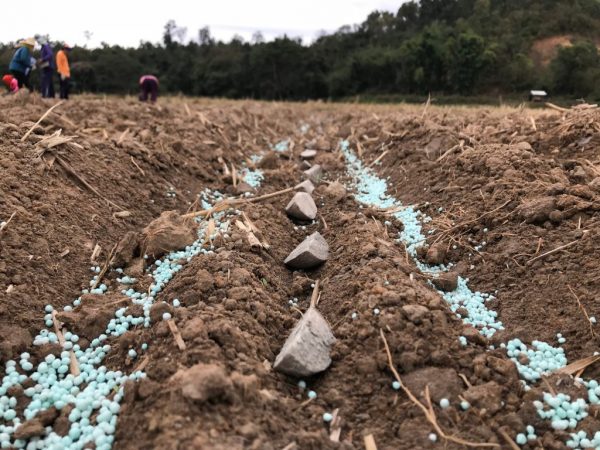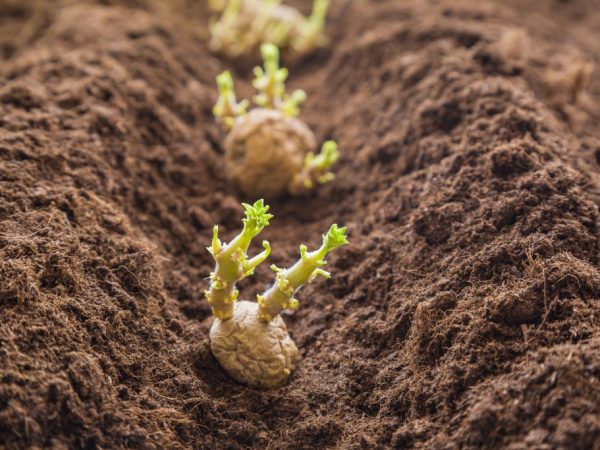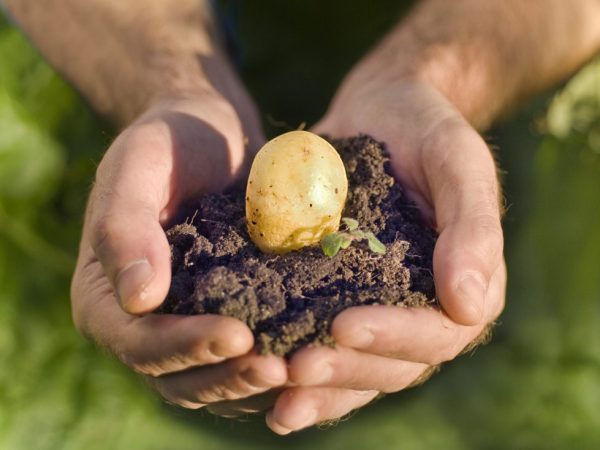What fertilizer to feed the soil when planting potatoes
While cultivating potatoes, experienced gardeners noticed that this vegetable consumes a lot of nutrients from the soil during the growing season. The land is gradually depleted and becomes unsuitable for the cultivation of almost all agricultural crops. To prevent this from happening, you need to fertilize the potatoes when planting. Then the harvest will be good and the soil will remain fertile. But not everyone knows how to fertilize potatoes during planting most effectively, which top dressing to apply to the soil, and which directly to the holes.

Fertilizer for replenishing the soil when planting potatoes
Plant nutrients
During the growth of potato bushes, for the release of a full-fledged crop of tubers, they take various minerals and organics from the soil. Experts have determined that during the growing season of plants, 1m² is used to feed the tubers:
- about 15 g of pure nitrogen;
- up to 39 g of potassium oxide;
- more than 8g of magnesium;
- approximately 8-10 g of phosphoric acid.
You can also add some copper and boron, manganese and zinc to this. In order to replenish microelements in the soil, you need to know what fertilizers to apply when planting potatoes, how to fertilize the soil from autumn under the winter, what to use for foliar feeding.
In order for the soil to always remain fertile, you can add not only chemicals, but also organic matter. Plants are very demanding for adequate nutrition and if it is not enough, then one should not wait for a large harvest.
Dosage and choice of feeding
The amount and composition of dressings depends on the condition of the soil. If the soil on the site is completely sandy, marsh or sour peat, then it is better to pay attention to other crops, and not to potatoes. An abundant yield of production may not be obtained at all, and the tubers will grow small and tasteless.
The best soil for growing a plant is considered to be sandy loam and medium loamy soils. This crop grows well on breathable soils because carbon dioxide helps the tubers gain weight and, when exposed to it, the starch content in the fruit bodies increases. And starchy crumbly potatoes are more appreciated in cooking.
Autumn top dressing of the soil for potatoes
When introducing organic matter into the soil, several methods of feeding can be distinguished.
- Sowing green manure grasses and crops.
- Rotted compost and manure are used without green manure.
- Rotted bird droppings are used before digging the site.
These dressings decompose under the snow cover, make the soil nutritious and light, saturating it with all the necessary nutrients.

The soil must be fertilized
Siderata
As for the siderates, they are sown in the shovelled area in early autumn. To do this, apply:
- winter rye;
- legumes;
- white mustard;
- stern yellow lupine;
- alfalfa.
Grass is sown densely and evenly throughout the entire plot. If before frost the height of the plants exceeds 30 cm, then they are mowed at the root and left on the soil. Winter crops can be left to grow until spring. When warm days come, the plants are buried in the ground with a hoe or dug up the ground to a shallow depth of 20 cm.
Compost
Over-matured compost and manure (2 or 3 years old in compost pits) are mixed in equal amounts. A mixture is applied to the site: 40 buckets per 1 hundred square meters, leveled with a rake and dug up. When digging, all the components are embedded in the ground, but the ground is not leveled after that. If there are eggs or cysts of pests in the soil, then frost will destroy them, because clods of earth will give free access to icy air, insects and larvae.
Litter
Poultry droppings must be applied carefully, observing the norms. It is best to mix it with wood ash 1: 1 and scatter over the surface, 10 buckets per 1 hundred square meters, and dig up. Fresh manure and fresh bird droppings should not be used because they can burn young shoots.
Manure
You can prepare an infusion from slurry. For 1 bucket of water, take 1 bucket of manure or bird droppings and incubate at room temperature for 2 weeks, stirring constantly for fermentation. The finished mixture is diluted 1:10 with water, filtered and poured over the wells. The damp soil is abundantly covered with wood ash and the tubers are planted.
Mineral nutrients
To find out which fertilizer is best for planting, it is necessary to conduct a chemical analysis of the soil.
But usually the composition of the soil is determined visually. If legumes were grown in the garden, then they enrich the soil with nitrogen and its introduction into the soil can be limited to a minimum. An excess of this element will give an impetus to the increased growth of the aerial part of the bush, and the tubers will grow no larger than a walnut.
What fertilizers should be applied when planting seed potatoes, when sorrel crops and oxalis were abundantly growing on the site? In this case, it is necessary to add phosphate rock to the holes, which neutralizes the acidity of the soil. It can be mixed in equal amounts with bone meal and granular superphosphate. 5 kg of the mixture is applied to 1 hundred square meters.

We fall asleep fertilizer
The amount of mineral fertilizers
For autumn soil cultivation, various minerals can be effectively used to fertilize the soil. It is best to process the garden before the onset of frost. For 1 hundred square meters you need to make:
- 1.2kg superphosphate;
- 1.9 kg of potassium sulfate;
- 0.9 kg of urea;
- 1.1kg of ammonium nitrate.
The last 2 components will give the best effect in the spring placement of fertilizer in the ground before planting potatoes.
If the gardeners are late with the autumn fertilization, then this procedure can be carried out in the spring. The composition of dressings per one hundred square meters remains the same, only some components are added. Fertilizers for planting potatoes are supplemented with wood ash - about 5 kg, nitroammophos - up to 3 kg and nitrophos - at least 3 kg, or use a complex mineral fertilizer, according to recipes for use.
Adding dressings to the hole before planting
Wood ash
The best of all fertilizers is wood ash, which is recommended by experts. It contains magnesium, potassium and phosphates. Enough 5 tablespoons of ash per hole to provide the plant with all the necessary inorganic nutrients. 750g of dry humus is added to the ash, mixed in the hole and the tubers are planted.
Litter
The soil in the holes can be enriched with useful substances using bird droppings. The litter, aged for 2 years, is dried and ground to a powdery state. Mixed with rotted compost 1: 1 and placed on the bottom of the pit. Pour a handful of chopped onion husks on top. The husk serves as a component of top dressing and repels small pests such as wireworms, cicadas and nematodes.
Artificial fertilizers
Along with organic matter, a complex mineral fertilizer is used for potatoes when planting tubers in holes. It should not be applied throughout the entire site, because the roots of the plant cover a small area and it is enough for them to feed in the radius of the holes. You can add 2 tablespoons of micronutrient fertilizer to the planting pits immediately before planting the seed.

Good potatoes in fertilized soil
Microfertilizers (Zerebra Agro and Kemira)
Chemicals are added to the pits, calculating their amount per 1m². This area must be entered:
- 7g of urea or 10g of ammonium nitrate;
- 85g magnesium sulfate;
- 25g dolomite flour;
- 35g nitrophosphate.
Very often, gardeners use professional fertilizing such as Zerebra Agro and Kemira. Their introduction into the soil must comply with the instructions found on the packages.
Giant
One of the most effective fertilizers is the drug Giant. It can be purchased in the form of granules that dissolve well in water. The composition of Giant contains peat, phosphorus, potassium and nitrogen in quantities necessary for the full development of plants and the formation of tubers. To add to the wells, it is enough to use 1 tablespoon of granules or powder, and for the first watering of the potatoes, a solution is made: 55 g of the drug must be added to a bucket of water.
Each gardener decides for himself which fertilizer is best for potatoes when planting on his site. He knows the composition of the soil and the weather characteristics of the region of residence. It should be borne in mind that the introduction of dressings directly into the holes provides a faster supply of nutrients to the area of the root system. Potato roots are limited in growth, so if the nutrients are outside the ridges, they will not benefit the plant.
Tuber processing
To learn how to fertilize potatoes when planting, you need to rely on the experience of gardeners. Some of them recommend treating the tubers. To do this, you can use:
- boric acid;
- potassium permanganate;
- copper.
The presence of these substances in seed potatoes will ensure good development of the root system and abundant flowering, a large number of strong and durable lashes.
Sometimes solutions can be purchased ready-made. But if there are none in the retail network, then it is easy to prepare them yourself. For 2 liters of warm water, take 0.8 g of each drug. The volume of the solution depends on the amount of planting material.
The tubers are packed in nets and dipped in liquid. The processing time ranges from 3 hours for small potatoes and up to 4.5 hours for large tubers. After that, the treated seeds are carefully removed so as not to damage the sprouts and planted in a permanent place.
Conclusion
Considering the question of what is the best way to fertilize potatoes when planting, we came to the conclusion that mixed dressings are effective. Using organic matter and mineral fertilizers, you can achieve good results and get a bountiful harvest. Large and tasty potatoes will appear on the table with proper care of the plants, observing the timing of watering and, of course, fertilizing the holes before planting seed tubers. After the plants grow, foliar dressings are applied.


